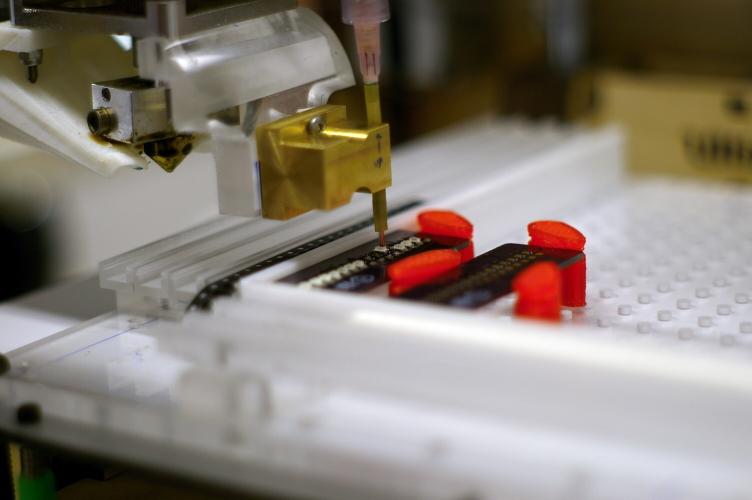When will 3D Printers be able to build electronic devices from the ground up? That’s a question many within the 3D printing space have been pondering for some time. Some experts feel as though it is only a decade away, while others think it could be a lot longer. Without a doubt, when this happens, it will change the world in ways that we could never imagine.
Close your eyes and think about all the electronic devices that you use on a daily basis. There are smartphones, TVs, PCs, home lighting, automobile key fobs, and the list goes on. Now imagine being able to 3D print some of these things, including the electronics, all on one machine. The world would become a much more productive place to live in, although there would certainly be many legal and intellectual property issues to deal with.
No worries though, this probably won’t be occurring anytime in the near future, right? Well, if a man named Eric Boyd and his four person team, have anything to say about it, we may be closer than it seems.
Boyd’s team has created a pick-n-place add-on for 3D printers, which will allow your 3D printer to created working printed circuit boards (PCBs). Pick-n-place machines have been around for quite a while. What they do is “pick up” surface-mount devices (SMDs) and “place” them onto printed circuit boards. They are efficient, precise, and very quick in doing so. They have the ability to place electronic components such as capacitors, integrated circuits, and resistors onto the correct spots on a circuit board.
Boyd’s add-on, which he calls the “Retro Populator” can easily be attached to a 3D printer, utilized, and then quickly removed.
“The (Retro Populator) is a pin plate with attached tape rails that slides into 3D printers,” Boyd told 3DPrint.com. “There is also a small mechanism which holds the vacuum syringe on the extruder head, and another small mechanism that adjusts the z-stage rezero height. The idea being that you can retrofit it into any 3D printer in about 2 minutes, do your pick ‘n place, and then take it back out again, 3D printer unchanged.”
Boyd’s motivation for creating this add-on comes from how tedious he has found the process of manually placing parts onto circuit boards. It requires good vision as well as great manual dexterity.
Boyd has plenty of improvements planned for his Retro Populator. Version 1.0 of the project is his first go at things, which you can see in action below:
“v1.0 does not support paste extrusion, part rotation, or tape advancement – basically, you can lay your parts out as you need them to be oriented on your circuit board, and move them to the right places, but you’ll need to do the orientation stuff yourself, as well as the solder paste, and even the tape cover peeling,” Boyd told us.
Boyd also has plans for the creation of Version 2.0 and 3.0 of the Retro Populator. Version 2.0 is currently in the planning and design process, and will allow a second nozzle to dispense solder onto the boards. It will also add either part rotation or paste extrusion (he is still undecided), and then in version 3.0 the other of the two features will be added. “The idea in ALL versions is to avoid any electronic changes or interfaces with the 3D printer,” Boyd told us. “We might have our own simple electronics, but we’ll never interface with the printers because that would make retrofitting so much harder.”
Below is a video, where Boyd explains a little more about the Retro Populator:
Boyd told us that he plans to begin selling these sometime at the end of this year or the beginning of next. “There will be several purchasable stages, starting at the v1.0 kit. The v1.0 kit is really just some machined plastic bits and a syringe needle + tube, so we’re thinking it’ll end up at something like $99, but we haven’t done the cost calculations yet,” he said.
Without a doubt this takes us one step closer in the quest to be able to fully print out electronic devices. Is this the final step in the process? Absolutely not. However, it is one step in the right direction.
What do you think about the Retro Populator? Would you have any interest in turning your 3D printer into a pick-n-place machine? Discuss in the Retro Populator forum thread on 3DPB.com. In the video below you can see Boyd explaining how to set the Retro Populator up on an Ultimaker 3D printer.
Subscribe to Our Email Newsletter
Stay up-to-date on all the latest news from the 3D printing industry and receive information and offers from third party vendors.
Print Services
Upload your 3D Models and get them printed quickly and efficiently.
You May Also Like
Consolidation in AM: How 2025 Is Shaping the Industry’s New Normal
The first half of 2025 has been marked by a clear shift in the additive manufacturing (AM) industry. Companies are no longer just focused on developing new tech by themselves....
Etsy Design Rule Change Reduces Selection of 3D Printed Goods
Online marketplace Etsy has implemented a rule change requiring all 3D printed goods on the site to be original designs. The update to the site’s Creativity Standards states, ¨Items produced using...
U.S. Congress Calls Out 3D Printing in Proposal for Commercial Reserve Manufacturing Network
Last week, the U.S. House of Representatives’ Appropriations Committee moved the FY 2026 defense bill forward to the House floor. Included in the legislation is a $131 million proposal for...
Transforming From Tourist to Native: Duro CEO Michael Corr Explains Why the Company Rebuilt its PLM Software on AI
In these early innings of the AI boom, many market analysts have expressed concern that AI spend has gotten too far ahead of the technology’s proven ability to deliver significant...


































